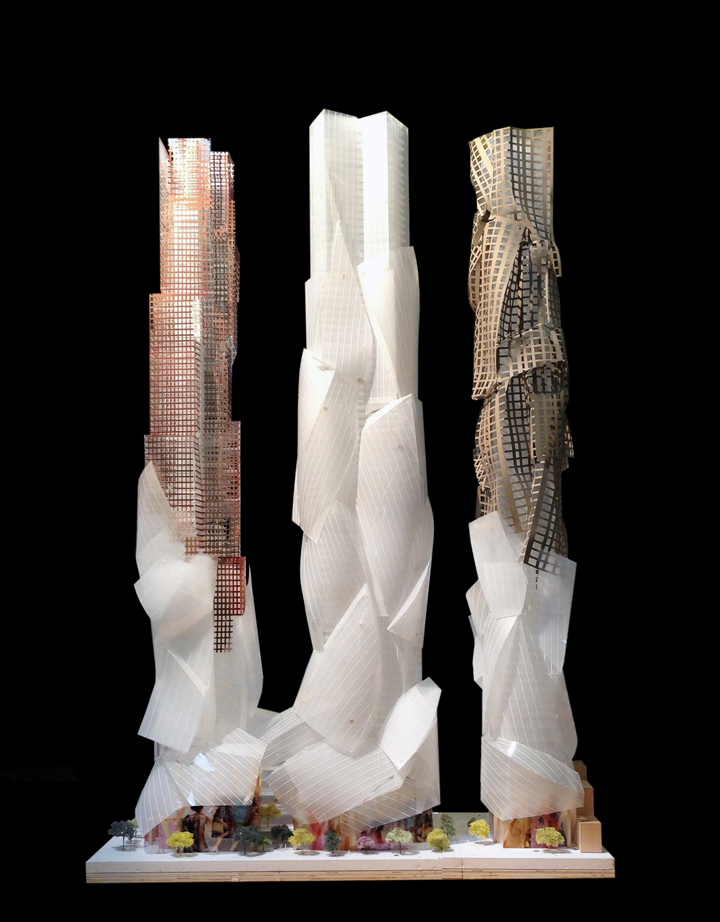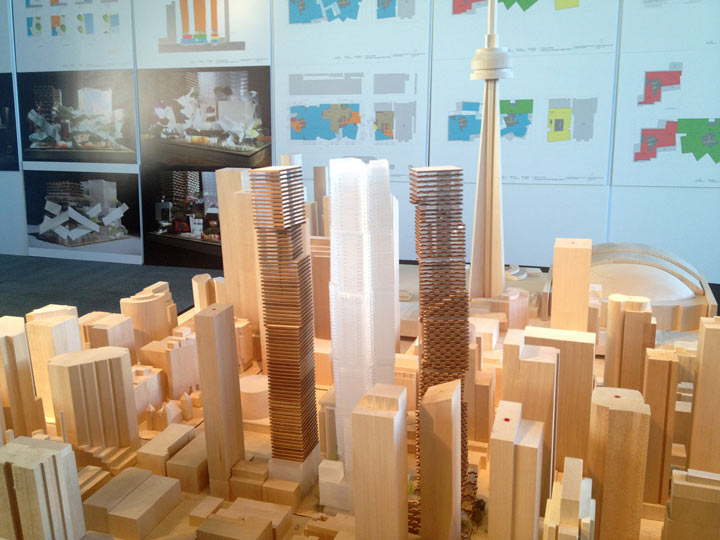TORONTO – When one of the world’s most renowned architects wants to transform a neighbourhood in your city, you would think the obvious next step would be to say yes.

When Frank Gehry returns to his hometown and says he wants to build a project featuring breathtaking architecture, university and gallery space, retail, residential and would create a public realm in the heart of the financial district, you let him do it.
Right?
Not so fast, says Toronto’s city planners.
Frank Gehry teamed up with theatre mogul David Mirvish to dream up a project that would replace the Princess of Wales Theatre with three 80+ storey residential towers arguably unlike anything the city has ever seen.
The project includes two six-storey podiums that would house a public art gallery, campus space for OCAD University and retail. (You can read more about the project details here).
Critics of the project have raised concerns — the height of the towers, the density, the strain on infrastructure — can the neighbourhood handle a project of this magnitude?
In a statement to Global News Toronto’s city planning department said that it’s concerned about the sheer size and complexity of the development.
“The proposal represents an amount of development not anticipated in the area,” read the statement from director of community planning Gregg Lintern. “The City has to consider how much the area can sustain and what the right scale is for the project.”
Walking around Toronto on Saturday during Nuit Blanche reminded us the impact art, culture and community can have on a neighbourhood. Thousands of residents and tourists marvelled at larger-than-life sculptures that had popped up in public spaces for the all night art extravaganza.
But unlike a brick and mortar gallery these temporary works of art will be dismantled after the dusk-to-dawn event wraps.
Gehry’s work of art would remain, and according to those behind the project would “create a new visual identity for the city’s premier arts district.” It would also house 60,000 sq feet of gallery space displaying David Mirvish’s private collection of contemporary abstract art.
At last week’s Empire Club luncheon, Mirvish told the sold-out crowd Gehry’s dream for King Street West isn’t just another condo tower for Toronto’s rapidly rising skyline. He argues it would take back the public realm, creating a space where Torontonians can live, shop, visit a gallery, right where they work.
His project would invite the public into the neighbourhood throughout the day, not just when a show is on at the Royal Alexandra Theatre and a crush of people clog the street, for a few shorts hours, then retreat to their homes elsewhere.
When presenting the project proposal, Mirvish said the city basically told him to “fit in” – scale back the original plan and squeeze one tower into existing space – effectively negating the goal of reclaiming the public realm at King and John.
Gehry’s latest model for the project (#44 out of a likely 75) features three residential towers ranging from 80 to 85 storeys. That’s a huge influx of people moving into the neighbourhood. Mirvish said the height and density of the condo towers are needed to pay for the architecture and the art gallery.
The project is bold – perhaps too bold for Toronto as it stands today – but as architectural critic Christopher Hume said – it anticipates the city’s future – a future where there are no more cars on King St. and the John St. corridor as a cultural hub has been fully realized.
The Mirvish+Gehry plan would also see four warehouse buildings demolished. The city says they are culturally significant.
But are these buildings more important than Frank Gehry? No, Mirvish remarked, they are not.
On Monday, Toronto’s chief planner Jennifer Keesmaat told Christopher Hume that the project’s plan for the heritage buildings is “poor” and “trite.”
To justify the density of the mixed-use complex and demo of the warehouses, “a much more significant contribution to the public benefit would be required for a project of this size,” Keesmaat said in an article for the Toronto Star.
There are examples throughout Toronto where large projects have been adapted to fit in to the existing neighbourhood; from vacant parking lots turned into “pocket parks” and the St. George St. revitalization, to connecting existing paths in order to create a city-wide trail.
But the city has had a long history of shelving projects that would have transformed city blocks into usable, celebrated public space. Mark Osbaldeston’s Unbuilt Toronto: A history of the city that might have been documents many of these plans, including the never-realized Federal Avenue, which would have connected Union Station to a civic square north of Queen St.
As of now the Gehry-Mirvish project is one big TBD.
Mirvish will take the plan to the Ontario Municipal Board with hopes the board will approve his project.
Gehry, meanwhile, will await next year’s opening of the Louis Vuitton Foundation for Creation in Paris, which boasts “sails” made of 3,600 glass panels, and will house exhibition and art space meant to promote, support and showcase as many works of art and cultural creations as possible.
“We wanted to present Paris with an extraordinary place for art and culture and demonstrate daring and emotion by entrusting Frank Gehry with construction of a building that is emblematic of the twenty-first century,” said Bernard Arnault, chairman and CEO of LVMH.
Gehry, now 84 and considered by many to be the most important architect of his generation, will wait to see if one of his final projects will take shape as he dreamed it in his hometown, or be shelved.




Comments